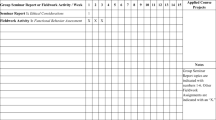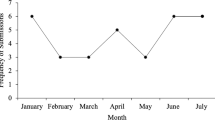Abstract
Decades of research in the field of behavior analysis has offered a framework to assess behavior–environment interactions across any population and setting that involves behavior. This foundation makes a behavior-analytic perspective of safety systems a vital area of applied behavior analysis and one that can have a tremendous impact on the tens of thousands of behavior analysts working in frontline and leadership positions in clinical settings. Given the important work being done by clinicians and the growing need for behavioral services worldwide, organizations should create systems that are measured by more than just outcomes. Systems should be built to support the safe and effective practices that lead to those outcomes. This article discusses a behavioral safety model applied to clinical systems and showcases the role of training and coaching in the institutionalization of this model.
Similar content being viewed by others
References
Alligood, C. A., Dorey, N. R., Mehrkam, L. R., & Leighty, K. A. (2017). Applying behavior-analytic methodology to the science and practice of environmental enrichment in zoos and aquariums. Zoo Biology, 36, 175–185.
Association of Professional Behavior Analysts. (2014). 2014 U.S. Professional employment survey: A preliminary report. Retrieved from https://www.apbahome.net/global_engine/download.asp?fileid=04E4737B-0C81-494D-82A2-4C35F78ECD70&ext=pdf
Austin, J., Carr, J. E., & Agnew, J. L. (1999). The need for assessment of maintaining variables in OBM. Journal of Organizational Behavior Management, 19, 59–87.
Baer, D. M., Wolf, M. M., & Risley, T. R. (1968). Some current dimensions of applied behavior analysis. Journal of Applied Behavior Analysis, 1, 91–97.
Behavior Analyst Certification Board (BACB). (2017). Behavior Analyst Certification Board professional and ethical compliance code for behavior analysts. Retrieved from https://www.bacb.com/ethics/ethics-code/
Bucklin, B. R., Alvero, A. M., Dickinson, A. M., Austin, J., & Jackson, A. K. (2000). Industrial-Organizational Psychology and Organizational Behavior Management: An objective comparison. Journal of Organizational Behavior Management, 20, 27–75.
Bucklin, B. R., & Dickinson, A. M. (2001). Individual monetary incentives. Journal of Organizational Behavior Management, 21, 45–137.
Carr, J. E., & Nosik, M. R. (2017). Professional credentialing of practicing behavior analysts. Policy Insights From the Behavioral and Brain Sciences, 4, 3–8.
Carr, J. E., Wilder, D., Majdalany, L., Mathisen, D., & Strain, L. (2013). An assessment-based solution to a human-service employee performance problem: An evaluation of the Performance Diagnostic Checklist-Human Services. Behavior Analysis in Practice, 6, 16–32.
Cavalari, R. N. S., & Romanczyk, R. G. (2012). Caregiver perspectives on unintentional injury risk in children with an autism spectrum disorder. Journal of Pediatric Nursing, 27, 632–641.
Cooper, J. O. (1982). Applied behavior analysis in education. Theory Into Practice, 21, 114–118.
Evers, W. J. G., Brouwers, A., & Tomic, W. (2006). A quasi-experimental study on management coaching effectiveness. Consulting Psychology Journal: Practice & Research, 58, 174–182.
Frisch, C. J., & Dickinson, A. M. (1990). Work productivity as a function of the percentage of monetary incentives to base pay. Journal of Organizational Behavior Management, 11, 14–34.
Geller, E. S. (2005). Behavior-based safety and occupational risk management. Behavior Modification, 29, 539–561.
Grindle, A. C., Dickinson, A. M., & Boettcher, W. (2000). Behavioral safety research in manufacturing settings: A review of the literature. Journal of Organizational Behavior Management, 20, 29–68.
Jain, A., Spencer, D., Yang, W., Kelly, J. P., Newschaffer, C. J., Johnson, J., . . . Denner, T. (2014). Injuring among children with autism spectrum disorder. Academic Pediatrics, 14, 390–397.
Johnson, B. M., Miltenberger, R. G., Egemo-Helm, K., Jostad, C. M., Flessner, C., & Gatheridge, B. (2005). Evaluation of behavioral skills training for teaching abduction-prevention skills to young children. Journal of Applied Behavior Analysis, 38, 67–78.
Johnson, D. A., & Rubin, S. (2011). Effectiveness of interactive computer-based instruction: A review of studies published between 1995 and 2007. Journal of Organizational Behavior Management, 31, 55–94.
Johnston, J. M., Carr, J. E., & Mellichamp, F. H. (2017). A history of the professional credentialing of applied behavior analysts. The Behavior Analyst, 40, 523–538.
Komaki, J., & Barnett, F. T. (1977). A behavioral approach to coaching football: Improving the play execution of the offensive backfield on a youth football team. Journal of Applied Behavior Analysis, 10, 657–664.
Longton, J. (2015). A look at violence in the workplace against psychiatric aides and psychiatric technicians. Monthly Labor Review. https://doi.org/10.21916/mlr.2015.4.
Malott, R. W., & Garcia, M. E. (1987). A goal-directed model for the design of human performance systems. Journal of Organizational Behavior Management, 9, 125–129.
Martin, P. L., & Foxx, R. M. (1973). Victim control of the aggression of an institutionalized retardate. Journal of Behavior Therapy and Experimental Psychiatry, 4, 161–165.
Martinez-Onstott, B., Wilder, D., & Sigurdsson, S. (2016). Identifying the variables contributing to at-risk performance: Initial evaluation of the Performance-Diagnostic Checklist-Safety (PDC-Safety). Journal of Organizational Behavior Management, 36, 80–93.
Mawhinney, T. C., & Fellows-Kubert, C. (1999). Positive contingencies versus quotas. Journal of Organizational Behavior Management, 19, 35–57.
McGee, H. M., & Diener, L. H. (2010). Behavioral systems analysis in health and human services. Behavior Modification, 34, 415–442.
McSween, T. (2015). Five critical behaviors for safety leaders. Retrieved March 14, 2019, from https://www.qualitysafetyedge.com/images/pdfwp/QSE_Five_Critical_Behaviors_For_Safety_Leaders.pdf
McSween, T., & Matthews, G. A. (2001). Maintenance in safety behavior management. Journal of Organizational Behavior Management, 21, 75–83.
Molenda, M., & Russell, J. D. (2006). Instruction as an intervention. In J. A. Pershing (Ed.), Handbook of human performance technology (pp. 335–369). San Francisco, CA: Pfeiffer.
Petrock, F. (1978). Analyzing the balance of consequences for performance improvement. Journal of Organizational Behavior Management, 1, 197–205.
Phillips, J. (2010). How executives view learning metrics. Retrieved January 23, 2018, from http://www.clomedia.com/2010/12/03/how-executives-view-learning-metrics/
Reid, D. H., & Parson, M. B. (2000). Organizational Behavior Management in human service settings. In J. Austin & J. E. Carr (Eds.), Handbook of applied behavior analysis (pp. 344–369). Oakland, CA: Context Press.
Rummler, G. A., & Brache, A. P. (1995). Improving performance: How to manage the white space on the organization chart (2nd ed.). San Francisco, CA: Jossey-Bass.
Seniuk, H. A., Witts, B. N., Williams, W. L., & Ghezzi, P. M. (2013). On terms. The Behavior Analyst, 36, 167–172.
Shapiro, E. S., & Shapiro, S. (1985). Behavioral coaching in the development of skills in track. Behavior Modification, 9, 211–224.
Sigurdsson, S. O., & Austin, J. (2006). Institutionalization and response maintenance in Organizational Behavior Management. Journal of Organizational Behavior Management, 26, 41–77.
Stokes, J. V., Luiselli, J. K., & Reed, D. D. (2010). A behavioral intervention for teaching tackling skills to high school football athletes. Journal of Applied Behavior Analysis, 43, 509–512.
Sulzer-Azaroff, B., & Austin, J. (2000). Does BBS work? Behavior-based safety and injury reduction: A survey of the evidence. Professional Safety, 45(7), 19–24.
Tilka, R., & Johnson, D. A. (2017). Coaching as a package intervention for telemarketing personnel. Journal of Organizational Behavior Management, 1, 49–72.
Weatherly, N. L., & Malott, R. W. (2008). An analysis of organizational behavior management research in terms of the three-contingency model of performance management. Journal of Organizational Behavior Management, 28, 260–285.
Wilder, D. A., Lipschultz, J. L., King, A., Driscoll, S., & Sigurdsson, S. (2018). An analysis of the commonality and type of preintervention assessment procedures in the Journal of Organizational Behavior Management (2000–2015). Journal of Organizational Behavior Management, 38, 5–17.
Wilk, L. A., & Redmon, W. K. (1998). The effects of feedback and goal setting on the productivity and satisfaction of university admissions staff. Journal of Organizational Behavior Management, 18, 45–68.
Author information
Authors and Affiliations
Corresponding author
Additional information
Publisher’s Note
Springer Nature remains neutral with regard to jurisdictional claims in published maps and institutional affiliations.
Rights and permissions
About this article
Cite this article
Weatherly, N.L. A Behavioral Safety Model for Clinical Settings: Coaching for Institutionalization. Perspect Behav Sci 42, 973–985 (2019). https://doi.org/10.1007/s40614-019-00195-1
Published:
Issue Date:
DOI: https://doi.org/10.1007/s40614-019-00195-1




